Choosing the right place to keep your digital stuff in the cloud is a big deal in 2025, especially as businesses lean more on cloud infrastructure. Cloud computing eats up 32% of IT budgets – that shows how central it is. Cloud storage services aren't just spots to dump files anymore; they've grown into smart systems that make collaboration, automation, and working from anywhere seamless.
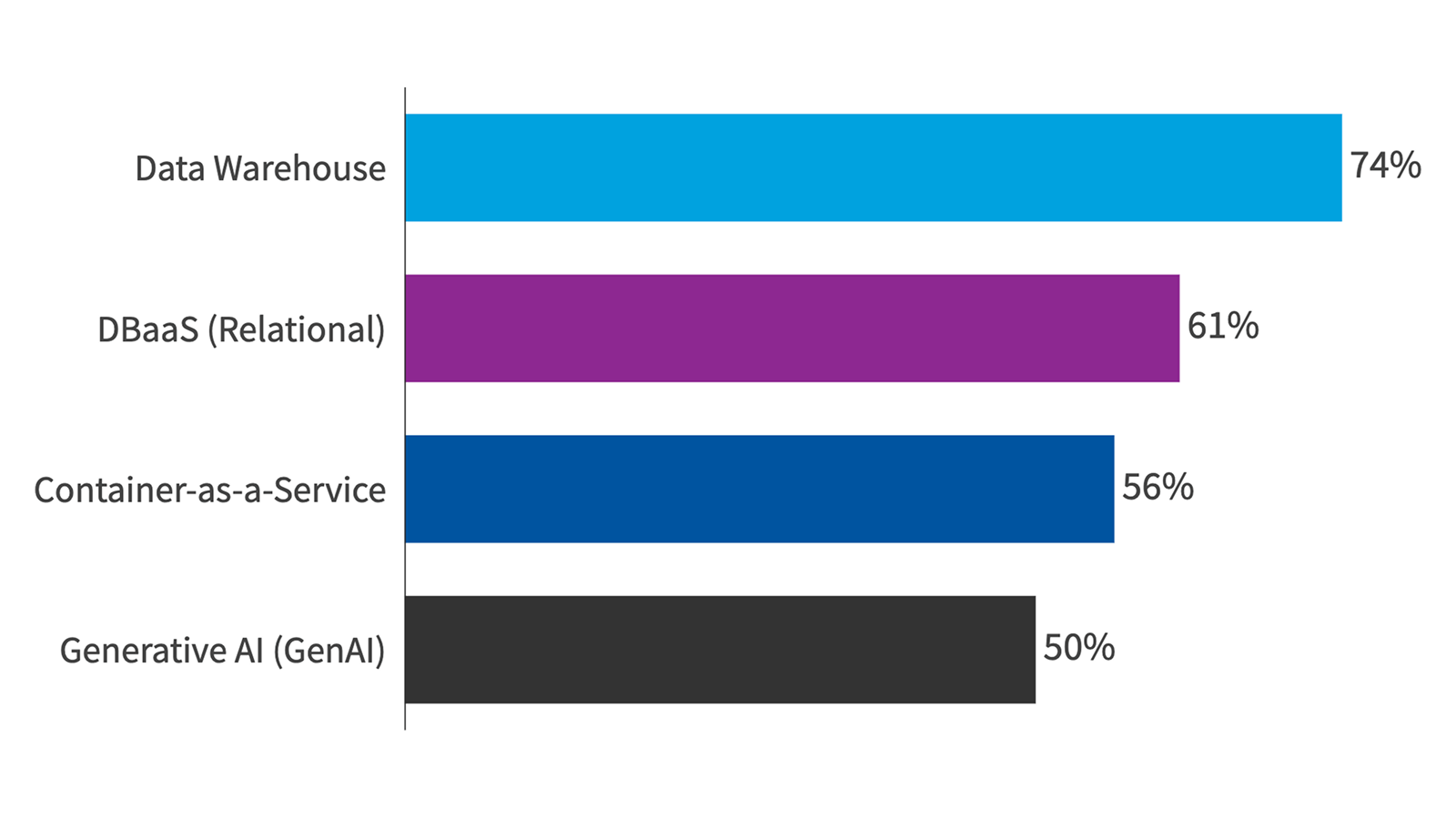
A recent study found that 61% of companies using the cloud said it made them more efficient and streamlined operations. For anyone working digitally – on a small team, running a business, or just a power user – choosing between platforms like Google Drive and Dropbox isn’t just about storage. It shapes how productive you are and how smoothly things run daily.
Quick Verdict: Pros and Cons of Dropbox and Google Drive
Dropbox and Google Drive each have standout strengths and a few weak spots. Here’s a quick look at what’s good and not so good:
| Dropbox Pros | Dropbox Cons |
| Faster file syncing (block-level technology) | Only 2 GB free, available in the cloud |
| Advanced sharing (passwords, expiry dates) | Higher cost for paid plans |
| Strong file versioning | No zero-knowledge encryption |
| Rewind function for account recovery | Limited built-in productivity tools |
| Linux compatibility | Business plans capped at 99 users |
| Google Drive Pros | Google Drive Cons |
| 15 GB free storage space | Slower syncing (full file uploads) |
| Affordable entry plans | No password protection for shared links |
| Seamless connection with Google's productivity suite | Limited version history |
| Strong search functionality | Malware scanning (privacy concern) |
Deciding between Google Drive and Dropbox comes down to what matters most. Dropbox is great for collaboration and control, while Google Drive offers better value and seamless Google tool integration.
Dropbox vs Google Drive: Free & Paid Cloud Storage Plans
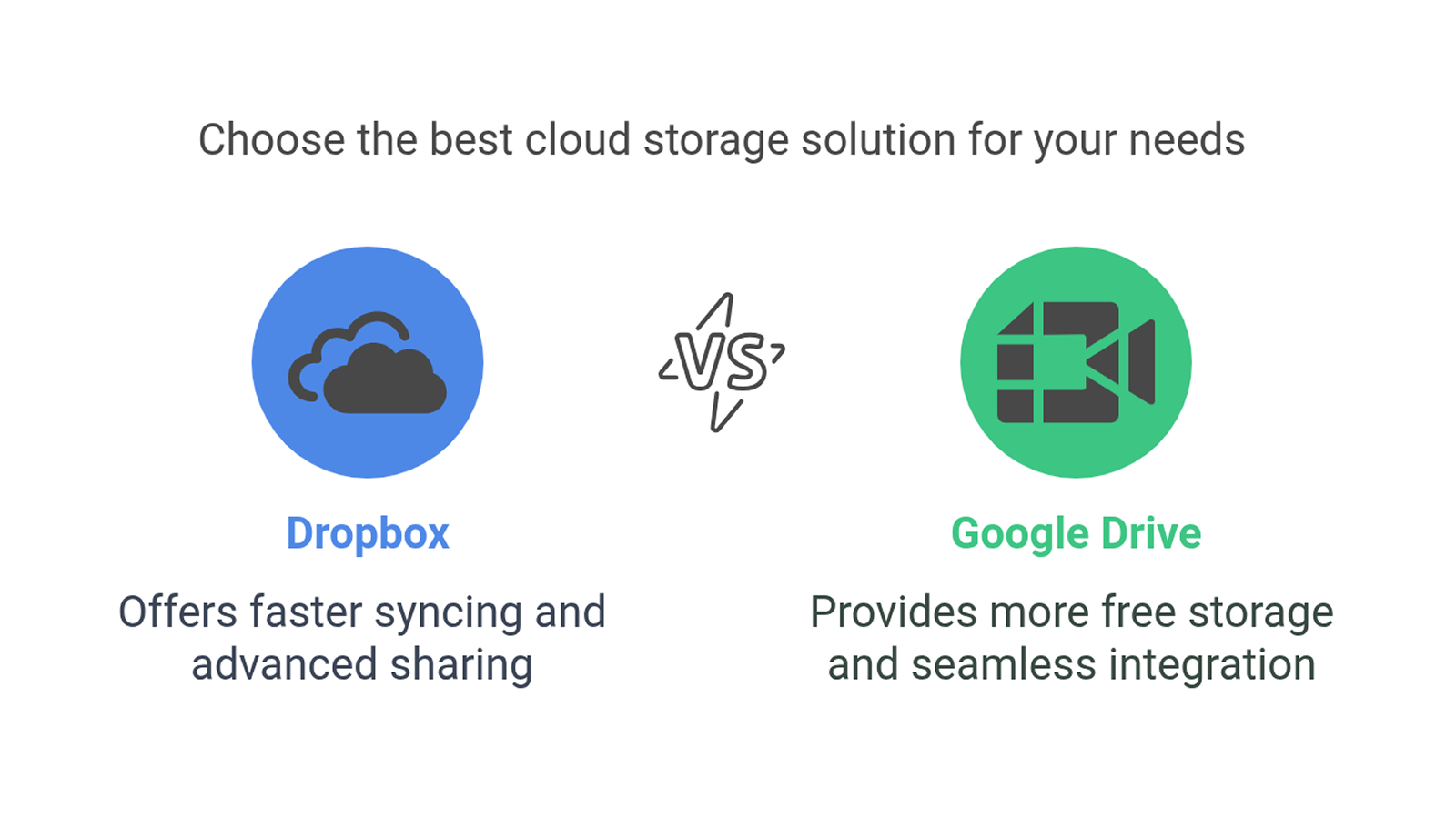
Free Storage Comparison
Let’s start with the free stuff. Google gives you 15 GB, but it’s shared across Gmail, Photos, and Drive. Dropbox starts with 2 GB just for your files, but you can boost it to 16 GB by referring friends. Both have mobile apps for photo backups, but large uploads eat through free space quickly.
Pricing Tiers and What You Get
Personal Plans
Both offer 2 TB for $9.99/month, but Google’s price is monthly, while Dropbox requires annual payment. Google’s $14/user Business Standard plan adds Workspace apps. Google also has a $1.99/month 100 GB plan. Dropbox skips mid-tier options, jumping from free 2 GB straight to 2 TB with extras like SmartSync.
Business & Enterprise Plans
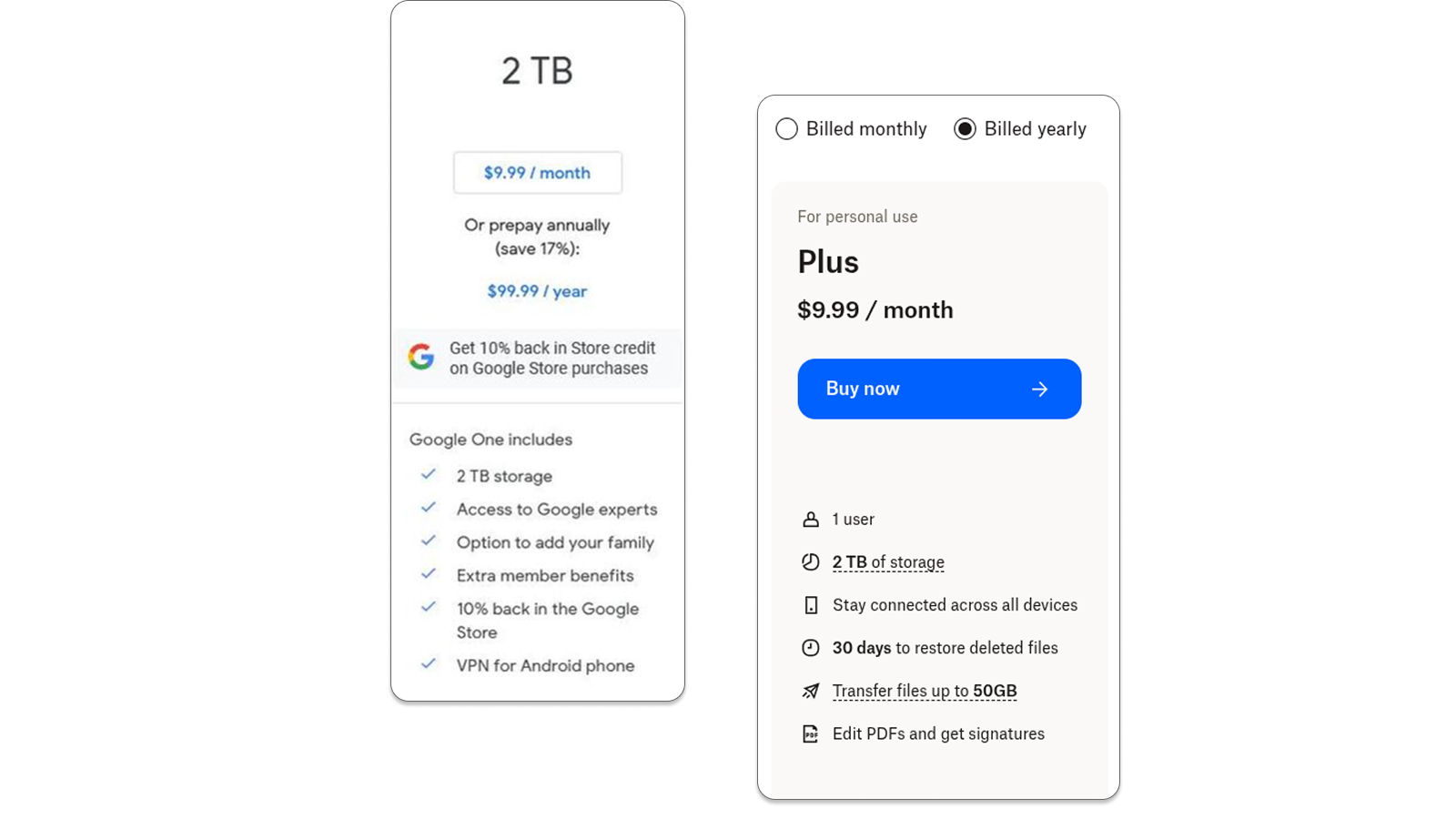
For teams, Google’s Business Standard is $14/user/month with 2 TB each (up to 300 users). Dropbox Business is $15/user/month for 9 TB shared (best for 3+ users, max 99). Google suits smaller teams needing individual space, while Dropbox fits organizations handling large files with advanced sharing and collaboration needs.
Value for Money: Which Gives You More?
If you need a bit of personal storage, Google Drive’s 15 GB free and $1.99/month plan is hard to beat. Dropbox costs more but offers extras like 180-day versioning, faster syncing, password-protected links, SmartSync, and strong team tools. For frequent sharing or enterprise use, Dropbox may be worth the higher price.
| Plan Type | Google Drive | Dropbox |
| Free | 15 GB (shared across services) | 2 GB (dedicated to files and folders) |
| Personal | $1.99/mo for 100 GB | $9.99/mo for 2 TB (annual billing) |
| $9.99/mo for 2 TB | $16.58/mo for 3 TB (annual billing) | |
| Business | $14/user/month for 2 TB per user (up to 300 users) | $15/user/month for 5 TB shared pool (minimum 3 users) |
Sync Speed & Performance: Is Google Drive vs Dropbox Faster?
How Sync Works: Block-Level vs Full-File
The biggest difference in performance is how they handle syncing. Dropbox uses block-level sync – it uploads only the changes you make, not the whole file. Google Drive uses full-file sync, re-uploading the entire file with every edit. So Dropbox is usually faster and more efficient, especially for teams working on large files.
Offline Access and Smart Sync Options
Both let you access files on your desktop, but Dropbox feels more flexible. SmartSync shows all files without storing them locally, saving space, and lets you mark folders for offline use. Google Drive also allows offline access, but you have to select files manually. Both back up mobile photos and videos, but free storage fills up fast — especially with Google’s shared 15 GB.
Real-World Upload and Download Test Results
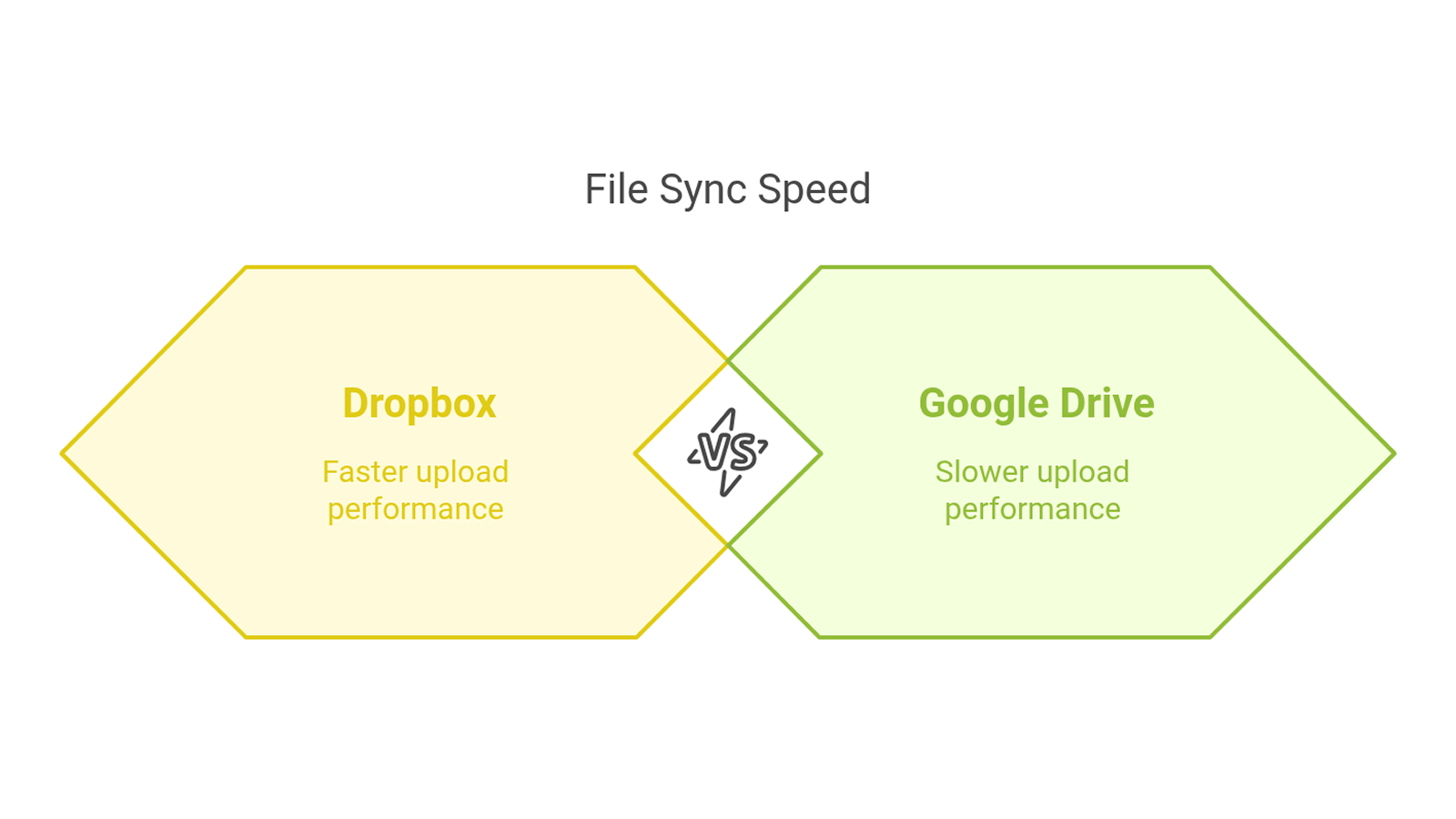
Based on tests like those done by 01net, Dropbox consistently shows faster upload performance compared to Google Drive. This is thanks to that block-level sync technology we talked about. Download speeds between the two services are usually pretty similar. But for teams dealing with lots of large files and needing faster, more reliable updates, Dropbox's efficient syncing gives it an edge.
File Sharing: Google Drive vs Dropbox File Permissions & Controls
Link Sharing Features
Password Protection, Expiration, Download Restrictions
When it comes to sharing files securely, Dropbox clearly pulls ahead of Google Drive, offering much more robust controls for shared links. Both let you share via email or a simple link, but Dropbox adds some crucial layers of protection:
- Password protection: You can require anyone opening the link to enter a password, a feature Google Drive simply doesn't have built-in.
- Expiration dates: Set links to automatically stop working after a certain date – great for time-sensitive access.
- Download restrictions: You can disable the option for people to download copies of the files, which helps keep your digital assets under control.
These extra features make Dropbox a really good choice for professionals who handle confidential or sensitive materials, like marketing agencies sharing work with clients.
Large File Transfer Capabilities
If you need to send really big files, Dropbox leads with its Dropbox Transfer feature, letting you send up to 100 GB. That’s well beyond Google Drive’s lower direct transfer limits, even though its overall storage goes up to 5 TB. It’s great for large videos, architectural files, or big data sets. Dropbox also adds delivery confirmations, customizable download pages, and stats on who accessed your files.
Collaboration Features: How These Platforms Help You Collaborate
Real-Time Document Collaboration
Docs, Sheets, Slides vs Dropbox Paper
Both Dropbox and Google Drive support real-time collaboration but in different ways. Google’s Docs, Sheets, and Slides offer seamless editing, comments, suggestion mode, and strong version history – ideal for text and spreadsheets. Dropbox Paper provides a clean, media-friendly space with great commenting and code block support, making it better for creative teams and brainstorming.
Notifications, Task Assignments, and Comments
For tracking activity and assigning tasks, Google Drive leads. Its customizable notifications can be based on folders, comments, or edits, and sent via email, browser, or app. You can turn comments into tasks with due dates via Google Tasks. Dropbox’s notifications are less flexible, and its task features are basic. Google also allows tagging specific text for detailed feedback.
Which Platform Works Best for Distributed Teams?
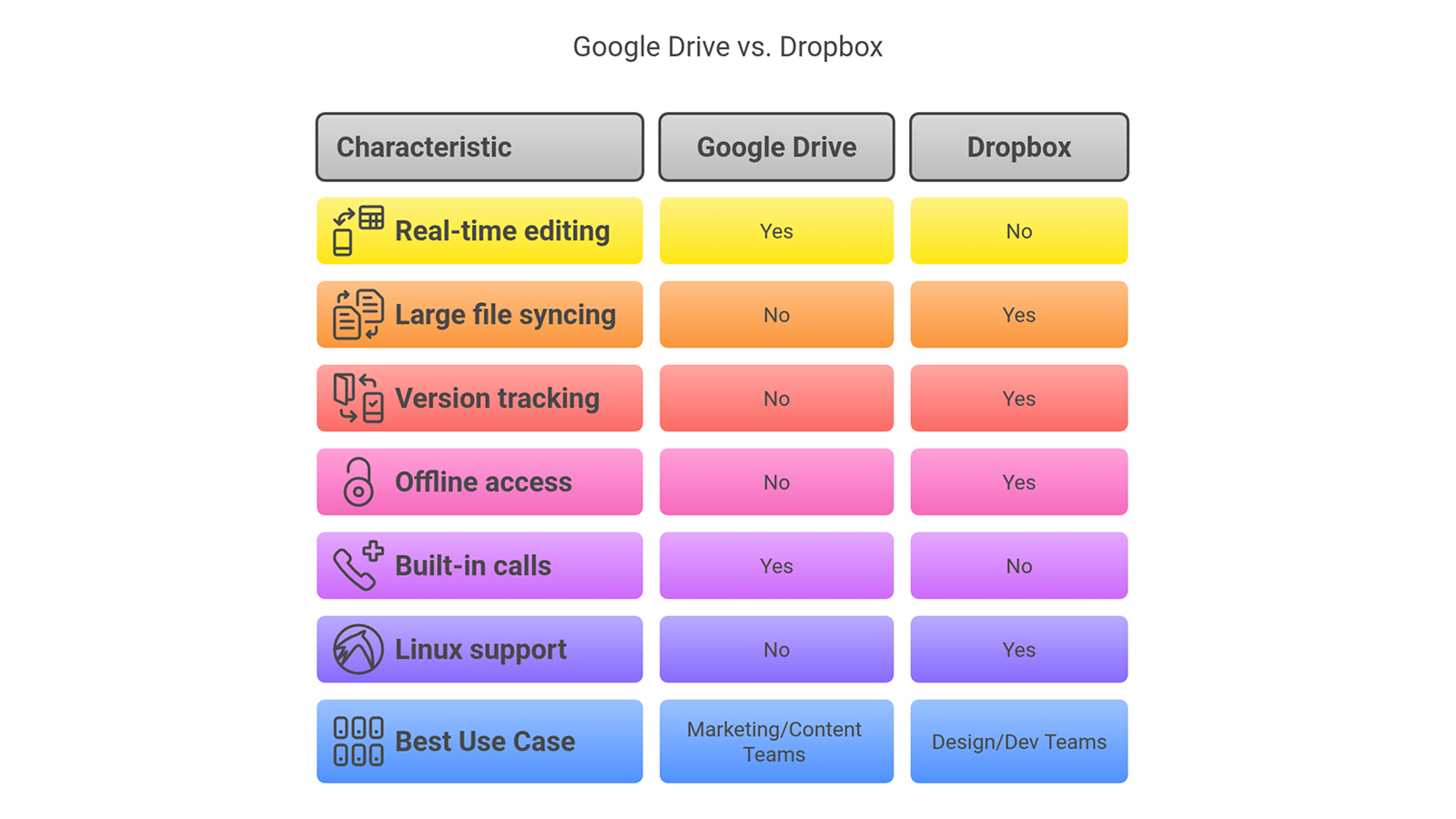
For remote teams, Google Drive shines when everyone needs to work on the same doc. You see cursors, assign actions, and jump into Google Meet – perfect for teams who live in documents. Dropbox excels at syncing big files, secure sharing, version tracking with "Rewind," SmartSync, and Linux support – a favorite for developers and design teams. Design teams with huge assets may prefer Dropbox, while marketing and content teams often lean toward Google Drive. Many teams use both: Google for docs, Dropbox for storing and sharing final assets.
Version Control & Backup: Recovering and Managing File History
If you care about file backup and version history (and you should), there are key differences. Both offer 30 days on standard plans, but Google caps at 100 versions per file. Dropbox can keep unlimited versions for 180 or 365 days, depending on your plan. Its standout "Rewind" feature rolls back your whole account — great for disaster recovery. For teams constantly updating files, Dropbox’s versioning is a big win.
Restore Options: Manual vs Automatic Rewind
Getting your files back works very differently. Google Drive makes you restore each file manually – preview, click restore, repeat. Fine for one file, a nightmare if lots are messed up. Dropbox’s Rewind is like a time machine: pick a date, and everything goes back to how it was. Way faster, way less painful – and a lifesaver when things really go wrong.
Long-Term File Retention for Businesses
When picking Google Drive or Dropbox for business, long-term file retention really matters — especially for compliance. Dropbox gives you 30, 180, or 365 days of version history, and Business Plus adds legal hold to stop files from being deleted — great for regulated industries. Google Drive caps non-Google files at 100 versions, and for serious retention or compliance, you’ll need Google Vault, which means extra cost and setup — not ideal for finance or healthcare.
Security & Privacy: Dropbox and Google Drive Privacy Compared
Encryption Types: AES-256, TLS, and Client-Side Options
Both platforms use strong security: AES-256 encryption at rest, TLS/SSL in transit. Google uses two rotating encryption keys, Dropbox uses one. Both support two-factor login, but Google offers more options — including physical security keys. With Workspace, Google also allows client-side encryption, so only you hold the keys.
Zero-Knowledge Encryption: What's Missing?
Despite strong security, neither Dropbox nor Google Drive offers true zero-knowledge encryption — they hold the keys and could access your data if required. If total privacy is your priority, services like Tresorit, Sync.com, or pCloud are better bets. Some users also layer on tools like Boxcryptor, though that adds extra steps.
Data Residency and Compliance Issues
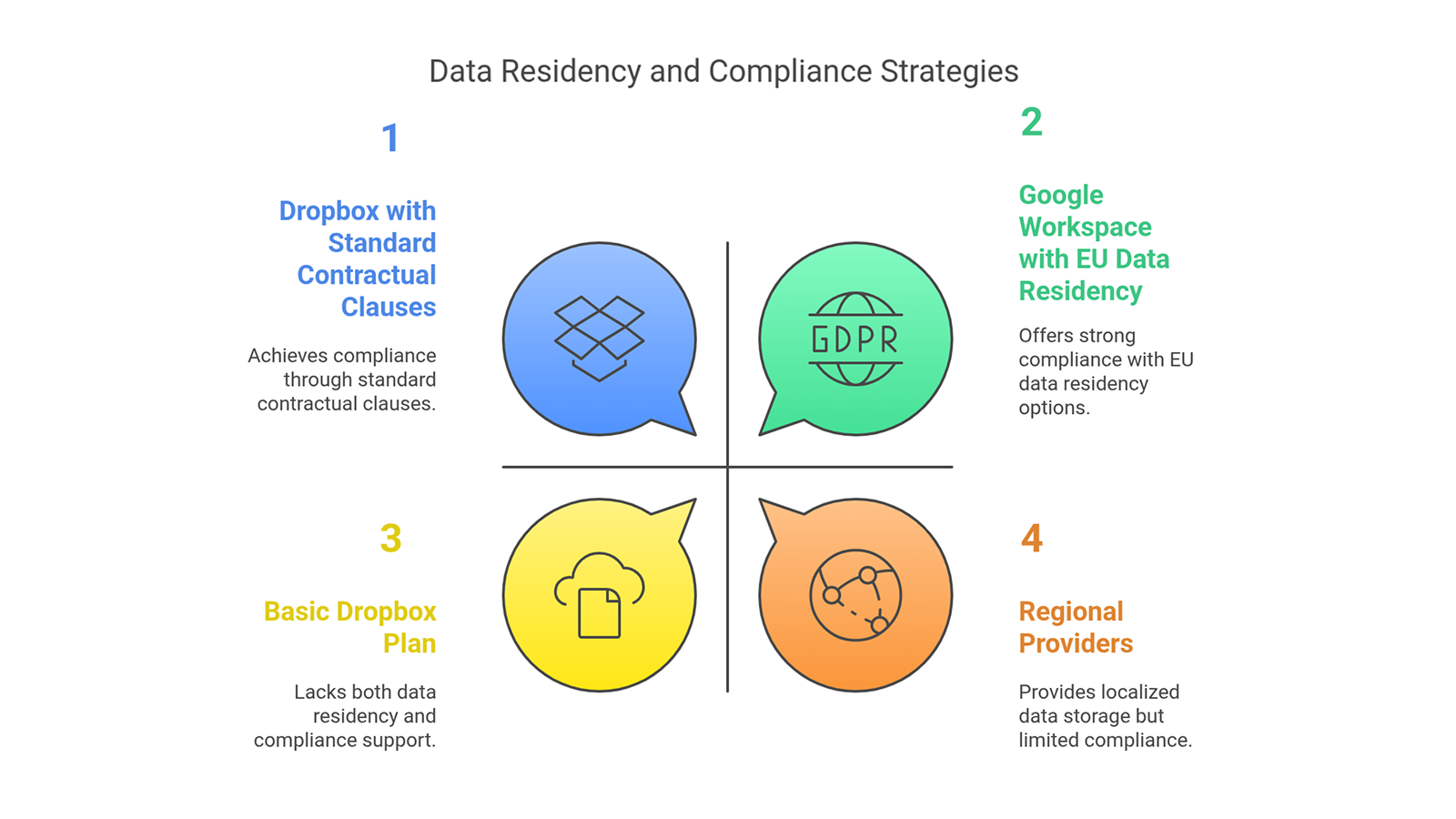
For businesses, knowing where data is stored matters — especially with GDPR. Both services keep data mainly in U.S. centers, which can be a concern. Google offers EU data residency for Workspace users; Dropbox doesn’t, but uses legal tools like Standard Contractual Clauses. Both support HIPAA, SOX, and GLBA on business plans with proper setup. For strict localization needs, regional providers or private cloud might be better.
App Integration & Ecosystem Support
Google Workspace Apps vs Dropbox Integrations
Both Dropbox and Google Drive connect with many apps, but in different ways. Google shines with its own tools – Drive ties in smoothly with Gmail, Calendar, Meet, and Docs editors, making workflows seamless if you're in the Google ecosystem. Dropbox doesn’t have its own suite but integrates well with Microsoft Office, Adobe Creative Cloud, and even Google tools. Drive is great if your team runs on Google; Dropbox is better as a flexible hub for mixed-tool workflows.
Popular Third-Party Tools Supported
Both platforms support many third-party apps, but with different focuses. Dropbox connects well with creative tools like Adobe, Office 365, Slack, Zoom, and Trello. Google Drive leans toward web-based tools, analytics, and CRMs like Salesforce, AutoCAD, and Asana. Dropbox suits creative teams, while Drive fits teams focused on web ops and business workflows.
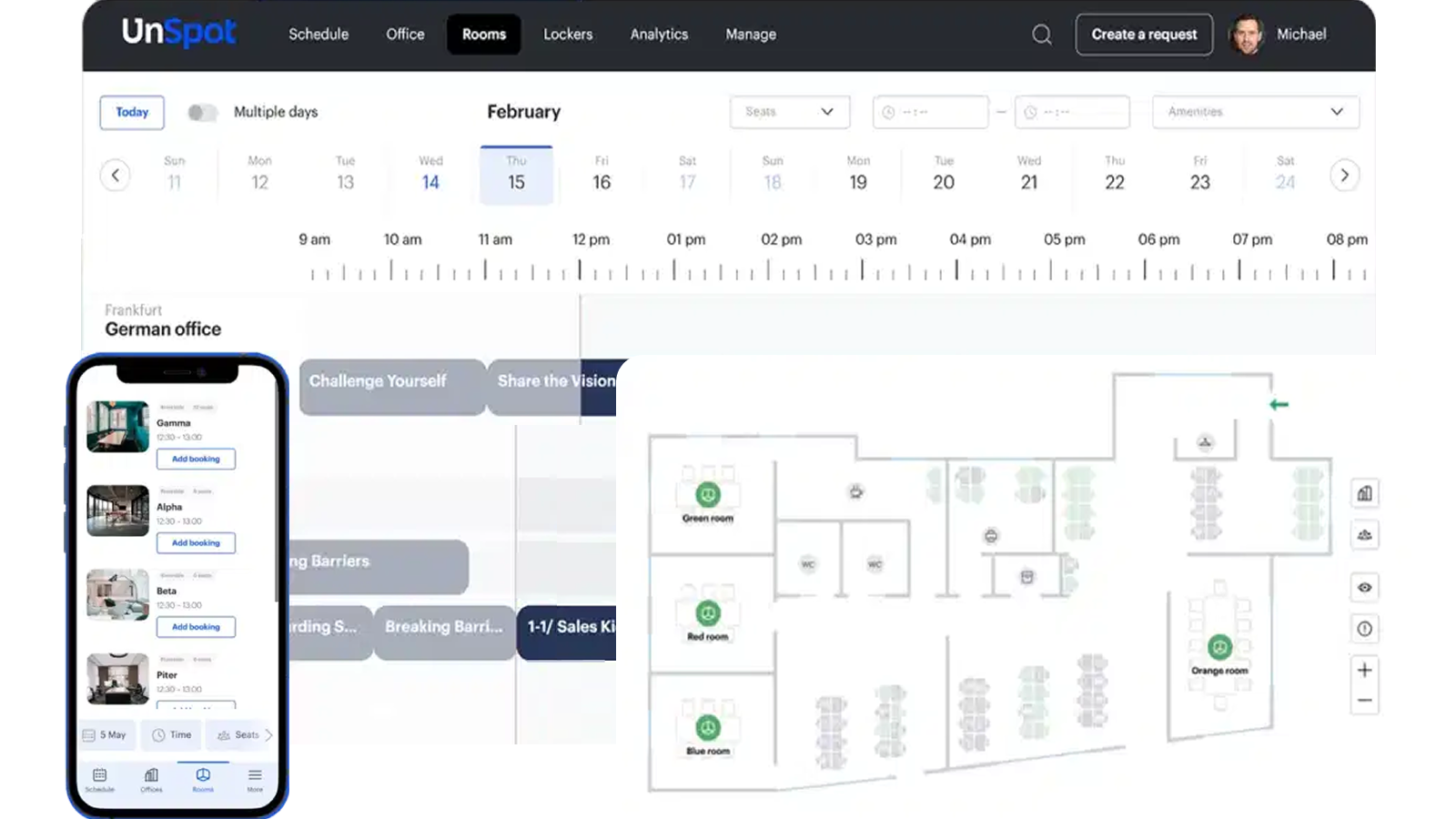
While Dropbox and Google Drive are all about managing your files, they don't actually help you organize your physical workspace or manage people's schedules. That's where UnSpot comes in. It offers tools for desk booking, managing meeting rooms, and scheduling hybrid work – and it can integrate with your cloud storage solutions. It helps teams manage their physical space and people as efficiently as they manage their data.
Best for Workflow Automation & SaaS Stack Integration
Which platform is better for automation depends on your setup. Google Drive is ideal for Google-based teams, with Apps Script and native links to Forms, Analytics, and Cloud tools. Dropbox is more flexible, working well with Zapier, webhooks, PDFs, and Adobe tools. Drive suits Google-centric stacks; Dropbox fits broader SaaS environments.
File Storage & Organization: Tagging, Previews, Search Tools
Media File Handling (Photos, Videos, PDFs)
Both platforms handle media well but in different ways. Google Drive is great for document and image previews, opens most file types in-browser, and connects with Google Photos for basic editing and organizing. Dropbox shines with video – it offers transcription, basic edits via Replay, high-quality previews, and better support for large files. It also handles PDFs better, with annotations, e-signatures, and version tracking, making it ideal for media-heavy teams.
Metadata, Smart Folders, and Search Suggestions
As storage grows, finding files fast is key. Google Drive shines with AI-powered search that understands context and gives smart suggestions like “presentations from last month.” Dropbox leans into structure, with deep folders, custom metadata, tags, and automation. For big, organized collections like marketing assets, Dropbox offers more control. But for content-based searching, Google’s smarter search may suit research teams better.
User Interface: Usability for Teams and Admins
Google Drive’s interface is clean, minimal, and easy to use — great for teams that aren’t super tech-savvy. The web app is strong, but the desktop version is more limited. Dropbox integrates better with your desktop, has a more feature-rich web interface, and offers detailed admin controls, though it can be a bit harder to learn. Tech-savvy teams often prefer Dropbox, while those wanting simplicity lean toward Google Drive.
Real-World Use Cases: Google Drive vs Dropbox for Your Needs
Choosing between Dropbox and Google Drive really depends on your specific job, team, and how you work.
Best for Solo Creators and Freelancers
Google Drive often offers better value with its generous 15 GB of free storage and integrated Workspace tools (Docs, Sheets, etc.). However, freelancers who regularly work with large audio or video files, or who need to send files securely to clients, might prefer Dropbox for its superior file-sharing features like password protection and link expiration.
Best for Startups and Growing Teams
Google Drive’s budget-friendly plans and seamless connection with Gmail and other Google tools make it a popular choice for startups watching their costs. As teams grow and deal with more files, Dropbox Business often stands out for its better file versioning (keeping files for up to 180 days is a big plus) and its efficient syncing that only updates modified parts of files.
Best for Creative Agencies or Video Teams
Creative teams, especially those working with video, often gravitate towards Dropbox. Features like video transcription, basic editing tools, file conversion options, its significantly faster uploads (up to 45% faster in some tests), and the ability to transfer huge files (100 GB+) are essential for managing large design and video assets smoothly.
Comparison by Industry Type
Here’s a quick look at which might be a better fit depending on your industry:
| Industry | Recommended Solution | Key Reasons |
| Education | Google Drive | Free space, collaboration |
| Legal | Dropbox | Secure sharing, file recovery |
| Healthcare | Dropbox Business Plus | HIPAA compliance |
| Marketing | Google Drive | Google tools connection |
| Software Development | Dropbox | Linux support, version control |
Visual Comparison Table: Dropbox vs Google Drive Feature Matrix
Here’s a side-by-side look at some key features to help you compare these cloud data storage platforms quickly:
| Feature | Dropbox | Google Drive |
| Free Cloud Storage | 2 GB (expandable through referrals) | 15 GB (shared across Drive, Gmail, and Photos) |
| Paid Plan | $9.99/month for 2 TB (Plus plan) | $1.99/month for 100 GB (Google One plan) |
| File Versioning | 30 days (Basic, Plus); 180 days (Professional, Essentials, Standard); 365 days (Business Plus, Advanced, Enterprise) | 30 days or 100 versions (for non-Google files); unlimited for native Google Docs, Sheets, and Slides |
| Block-Level Sync | ✅ Yes (only changed portions of files are uploaded) | ❌ No (entire file is re-uploaded after changes) |
| Password-Protected Links | ✅ Yes (with password and expiration date settings) | ❌ No built-in option; access must be manually restricted |
| Linux Support | ✅ Yes (official client available) | ❌ No official client (only third-party tools) |
| Multimedia Handling | Transcription and editing (Dropbox Replay) | Preview only |
| Max Upload Size | 2 TB (desktop app); 375 GB (web upload) | 5 TB (individual file limit) |
| Office Compatibility | Integrated with Microsoft Office and Google Workspace | Primarily integrated with Google Workspace; limited support for Office files |
| Best For | Media files, creative teams, Linux users | Document collaboration, Google ecosystem users |
Choose Based on Your Priorities: A Quick Decision Guide
Still trying to figure out which one is right for you? Use this quick guide to match the cloud platform to what you need most.
Decision Tree: Choose Dropbox | Google Drive Based on Your Goals
Are you focused on the budget?
👉 YES → Is 15GB enough?
👉 YES → Choose GOOGLE DRIVE (free)
👉 NO → Need <100GB?
👉 YES → Choose GOOGLE DRIVE ($1.99/mo)
👉 NO → Continue below...
Are large file transfers (>10GB) a must-have?
👉 YES → Choose DROPBOX
Need advanced security for sharing (like passwords)?
👉 YES → Choose DROPBOX
👉 NO → Choose GOOGLE DRIVE
Is Linux compatibility essential for your workflow?
👉 YES → Choose DROPBOX
Do you work mostly with multimedia (video, large images, PDFs)?
👉 YES → Choose DROPBOX
👉 NO → Choose GOOGLE DRIVE
Checklist: What to Consider Before Subscribing
Before you make your final decision, ask yourself these questions:
- Storage Needs: How much space do you really need in the cloud, both now and in the near future?
- Security Level: Is being able to password-protect files you share crucial for your work?
- File Types: Are you mostly handling standard documents, or lots of large media files (photos, videos, audio)?
- Syncing Speed: How important is it for files to update across devices instantly, especially if you edit large ones often?
- Budget: What's the most you're willing to spend per month (or per user for a team)?
- Collaboration Style: How do you typically work with others on files? Do you need real-time editing or just easy sharing?
- Existing Ecosystem: Are you already heavily invested in using Google's other apps like Gmail and Calendar?
- Recovery Needs: How far back do you need to be able to recover previous versions of your files, or even your whole account?
For many, the best move is a hybrid: Google Drive for everyday docs and collaboration, Dropbox for large media and secure sharing. It’s worth trying the free versions of both before deciding.
Conclusion: Final Verdict — Dropbox vs Google Drive in 2025
Looking at everything in 2025, Dropbox technically comes out slightly ahead for its core cloud storage functions – it offers faster syncing, better support for multimedia files, and stronger security features specifically around sharing.
However, the absolute "best" cloud-based storage solution truly depends on what you need.
- Choose Google Drive if you're keeping a close eye on your budget, primarily work with documents, and are already happy using Google's suite of business tools.
- Choose Dropbox if you regularly deal with large video, audio, or image files, require advanced security like password-protected links, need Linux support, or prioritize having the most efficient file syncing technology.
As we saw, many teams are finding success by combining both platforms – using Google Drive for collaborative document work and Dropbox for managing media assets and secure file distribution. The best advice is always to test drive both services if possible before deciding where to park your data long-term.







